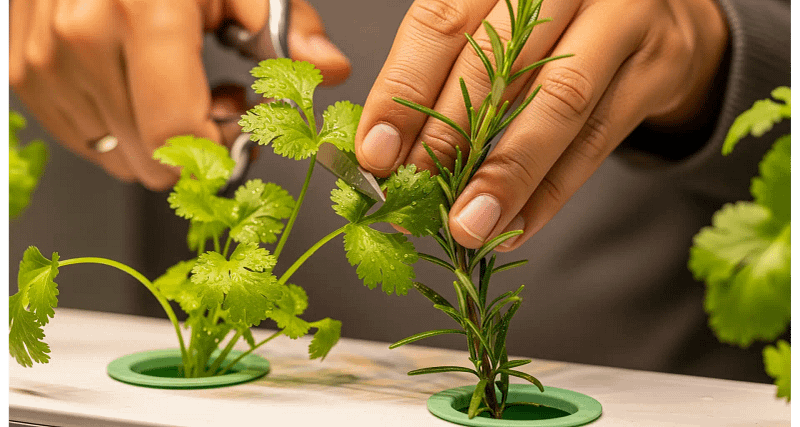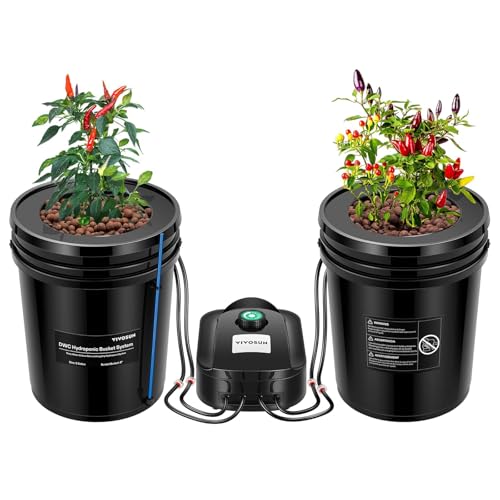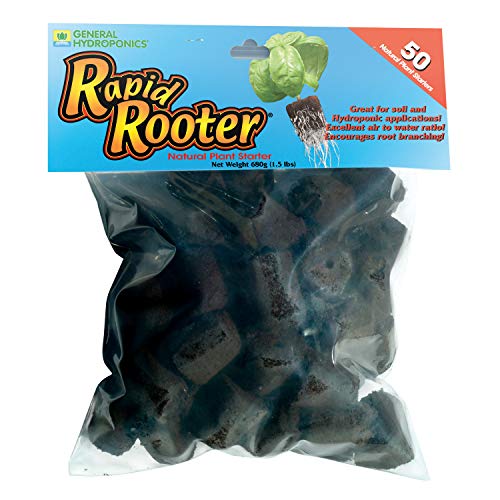Imagine a December evening. The wind howls, but inside, a world of sun-kissed flavors awaits. You snip a handful of glistening cilantro leaves, and they explode with a crisp, citrus-punch freshness, instantly transporting you to a vibrant market in Oaxaca. Next, you brush against a hardy rosemary sprig, and its potent scent—a mix of pine forest and warm earth—fills the air, a reminder of the rolling hills of Tuscany. This isn’t a summer memory; it’s your year-round reality. My name is Maria, but in my kitchen, they call me the Herb Alchemist. For twelve years, I have blended ancient gardening wisdom with the clean, precise science of hydroponics. I’ve learned that coaxing out these vibrant flavors isn’t about luck; it’s about understanding the deep, secret needs of each plant. I’ve had my share of failures—my first rosemary crop smelled like wet socks, and my cilantro bolted before I even got a taste—but each mistake taught me a truth. Let’s make sure you skip the failures and go straight to the flavor.
Note: Verify local regulations regarding indoor agriculture systems.
Why Soil Steals Essence: A Lesson from the Ancients
Growing herbs in soil is the traditional way, yes, but tradition can sometimes miss the point of perfection. Soil is a magnificent, complex living system, but it’s a buffet for a thousand diners. Your herb’s roots must compete for limited space, water, and nutrients. When your rosemary’s roots are fighting for every mineral, they don’t get to dedicate their full energy to producing those potent, resinous oils that make the herb so special. I’ve found that rosemary grown in a nutrient-rich aeroponic or hydroponic system contains a far higher concentration of these aromatic oils. It’s the difference between a faded photograph and a high-definition image.
My first big failure taught me this lesson. My beautiful rosemary plants, grown in a soil pot, had been overwatered. The soil suffocated the roots, and the plant, in a desperate attempt to survive, produced a chemical compound to fight off root rot. The result? Leaves that, when bruised, smelled not of a pine forest, but of wet, moldy earth. I would not serve that to my nonna. This is why we turn to soilless cultivation. Here, the roots don’t struggle; they are pampered. They have all the water and oxygen they could ever want, delivered precisely. This allows the plant to focus on what matters to us: producing the rich, fragrant compounds that fill our kitchens with joy.
Cilantro Conundrum Solved: The Cool-Root, No-Bolt Blueprint
Cilantro (Coriandrum sativum) is a plant that challenges even experienced gardeners. It has a single mission: to bolt. To shoot up, flower, and go to seed, leaving behind a sad, flavorless stem. But with the right technique, you can trick it into staying a leafy green, yielding a continuous, vibrant harvest.
Germination Warfare: The Seed Cracking Workshop
This is my nonna’s secret weapon. Cilantro seeds are actually two seeds, nestled together in a hard, protective husk. Without help, germination can be slow and inconsistent. Our strategy is simple: attack the husk!
- Crush: Place your cilantro seeds in a small plastic bag. Use a rolling pin or the bottom of a glass to gently crack the husks. You don’t want to pulverize them, just split the husk open to reveal the two tiny seeds inside. This is a game-changer for speeding up germination.
- Soak: Once cracked, soak the seeds in warm water for 24-48 hours. This softens the seed coat and signals to the seed that it’s time to wake up.
- Plant: Place a couple of seeds in a rockwool or coco coir cube and cover with a thin layer of the growing medium. Your germination rate and speed will skyrocket.
Cool Root Secrets: The 50-72°F Magic
Cilantro is a cool-weather herb. It hates heat, and that’s what makes it bolt. In traditional gardening, you’re at the mercy of the weather. In hydroponics, you are the master of the seasons. The key is to keep the root zone cool. Aim for a water temperature between 50-72°F (10-22°C).
This is your secret weapon against premature bolting. A small water chiller is an investment, but it’s the difference between a season’s worth of fresh salsa and a bitter, six-week failure.
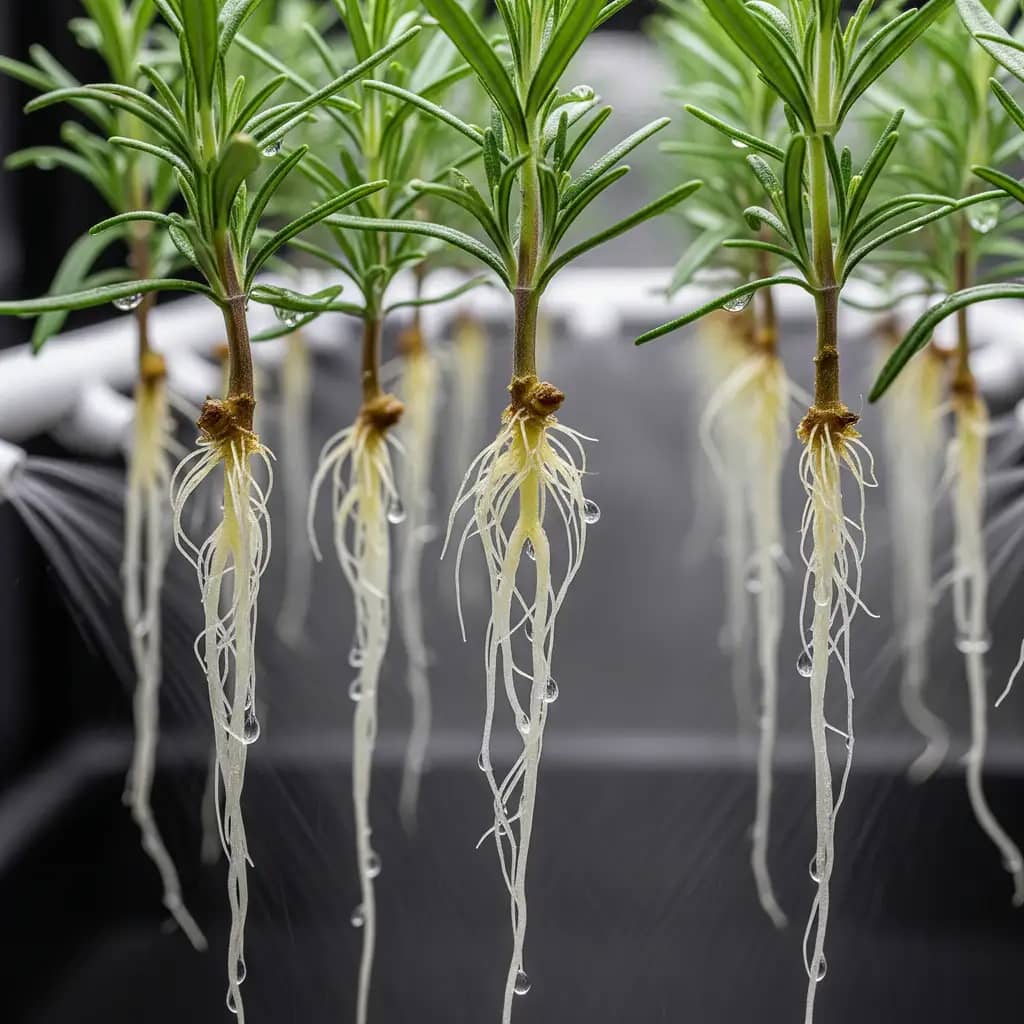
Rosemary Resilience Blueprint: Building a Pine-Scented Fortress
Rosemary (Salvia rosmarinus) is a perennial herb that, once established, is incredibly rewarding. But the journey to a strong, woody plant requires patience and a specific kind of care. Rosemary needs a lot of oxygen and despises wet feet, which is why hydroponics, and specifically aeration, is a perfect fit.
Oxygen Obsession: A Revelation in Aeration
Rosemary roots are like a stubborn old man. They don’t like to be wet all the time. My greatest failure with rosemary was in a DWC (Deep Water Culture) system. I thought continuous submersion would be a paradise. Instead, the roots suffocated, turned brown, and my plant died. It was a costly and aromatic failure—it smelled like wet socks.
The revelation was simple: rosemary needs oxygen. A lot of it. The best way to provide this is through an aeroponic system where the roots are suspended in air and misted with nutrient solution. This allows the roots to breathe between misting cycles.
A good air pump and air stone in a DWC system can also work, but for true rosemary potency and root health, aeroponics is my secret weapon. The roots of my aeroponic rosemary are thick, white, and healthy, and the leaves release a scent that truly transports you to a pine forest.
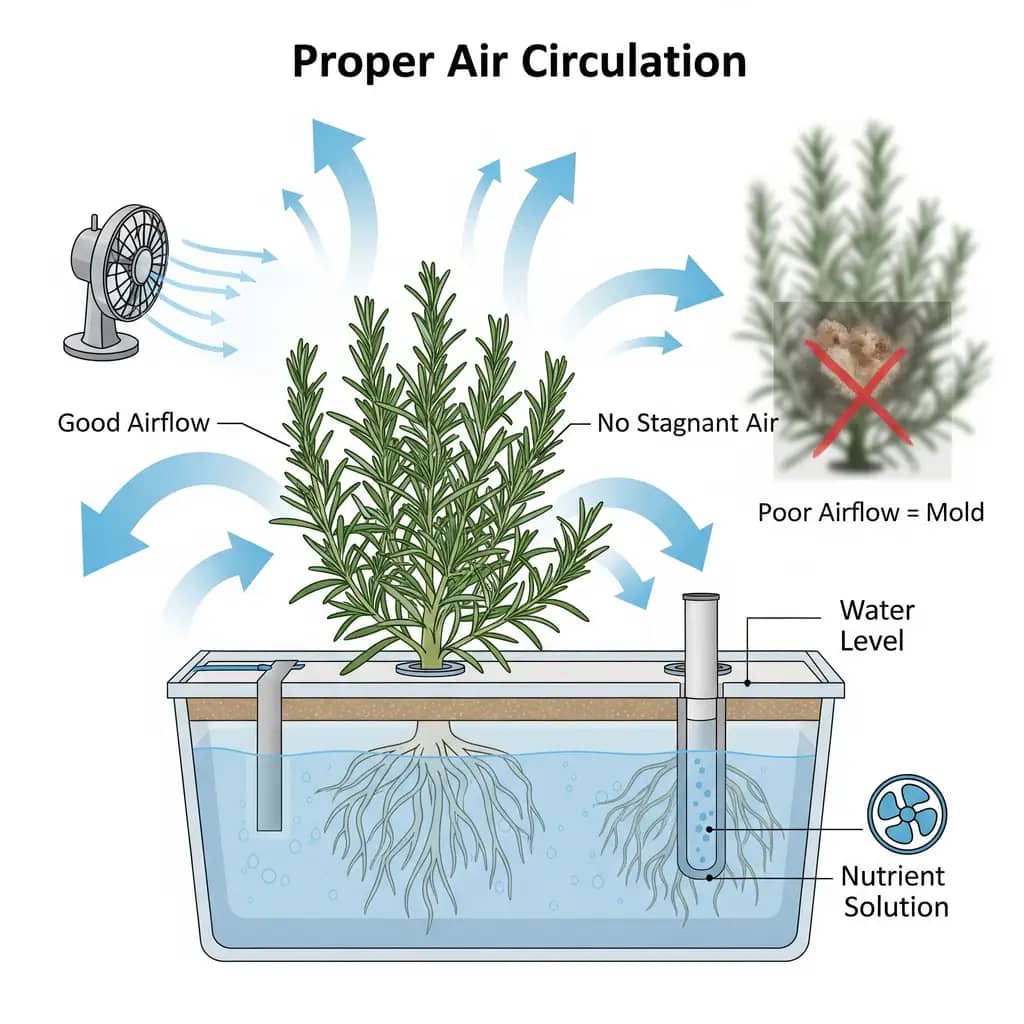
Mold Prevention Protocol: The Roman Way
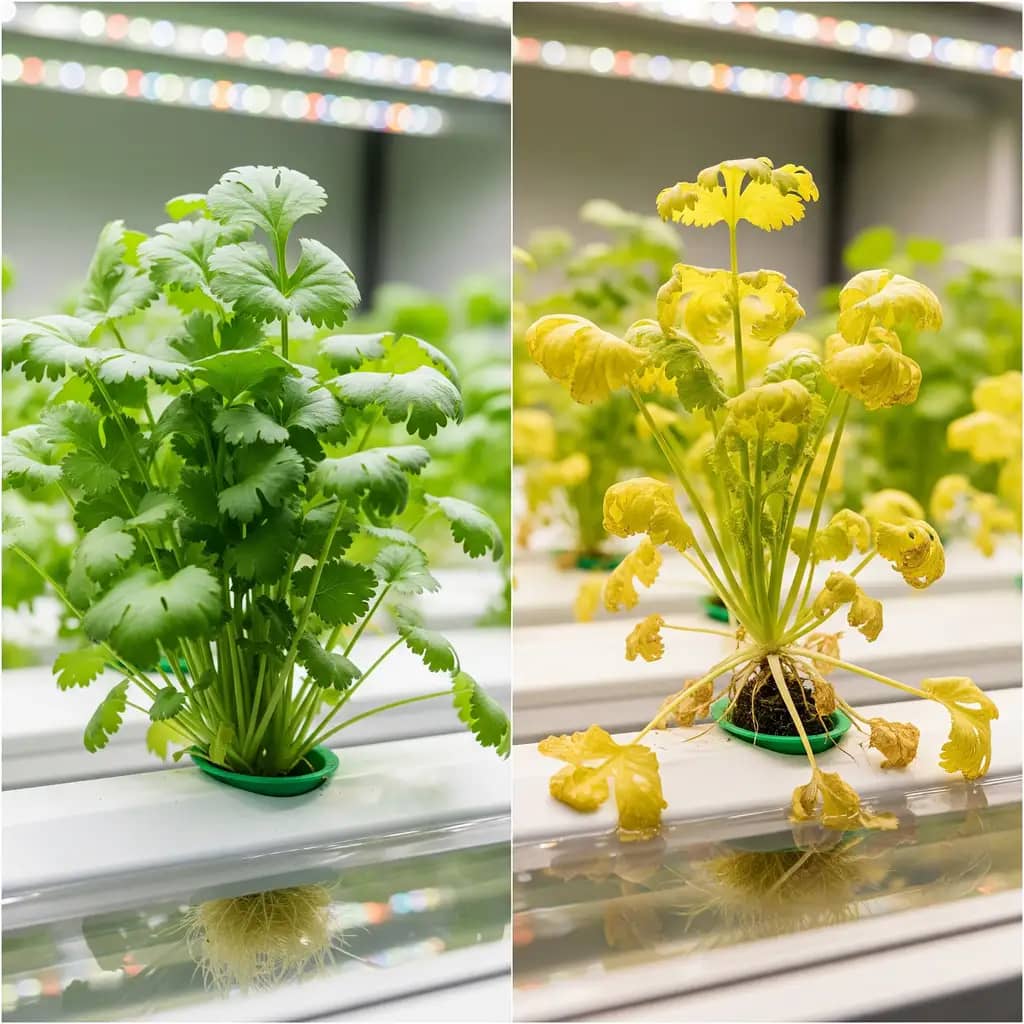
Rosemary’s love of good airflow is also its greatest defense against mold. The ancient Romans, who used rosemary as a symbol of remembrance, knew this. They would often plant rosemary on dry hillsides and ensure there was ample space between plants. We can apply this wisdom to our indoor gardens.
- Airflow is Everything: Just like basil and mint, rosemary needs vigorous air circulation. Use clip-on fans to ensure no air is stagnant, which is a prime cause of mold and fungal diseases like Botrytis.
- Pruning for Air: When you prune, don’t just harvest the tips. Thin out the center of the plant to allow air to flow through the dense branches. This is the oldest trick in the book for a healthy rosemary bush.
- Low Humidity: Rosemary thrives in a slightly drier environment than other herbs. Aim for a humidity level below 60% if possible.
Cilantro vs Rosemary Cheat Sheet: A Quick Guide
| Factor | Cilantro | Rosemary |
| Ideal pH | 6.5-7.5 (alkaline) | 5.5-6.5 (acidic) |
| Germination | Soak/crack seeds | Cuttings preferred |
| Water Temp | 50-72°F (cool) | 65-70°F |
| Key Challenge | Bolting prevention | Mold resistance |
| Harvest Time | 6 weeks | 3-4 months |
Shared Sanctuary: pH Perfection & Nutrient Nuances
These two herbs, though both from the sun-drenched Mediterranean, are like two siblings with opposite personalities. Cilantro loves a cool, alkaline home, while rosemary prefers it warm and acidic. You cannot grow them in the same reservoir without compromising one or both. A shared system would result in a bland compromise. Therefore, it’s best to grow them in separate systems where you can tailor the nutrient solution to their individual needs.
pH Perfection: The Radical Difference
The pH of your nutrient solution is more than a number; it’s the key to your herb’s ability to absorb food. For cilantro, with its love for limestone-rich soils, I’ve found the perfect pH is a slightly alkaline 6.5-7.5. It’s an outlier in the herb world, but ignoring this leads to nutrient deficiencies and yellowing leaves.
Rosemary, on the other hand, is a child of the pine forests. It thrives in slightly acidic soil, and the same is true in hydroponics. A pH of 5.5-6.5 is its sweet spot.
This is my nonna’s secret number one: Do not guess pH! A good pH meter is the single most important tool in your arsenal. Without it, you are blind.
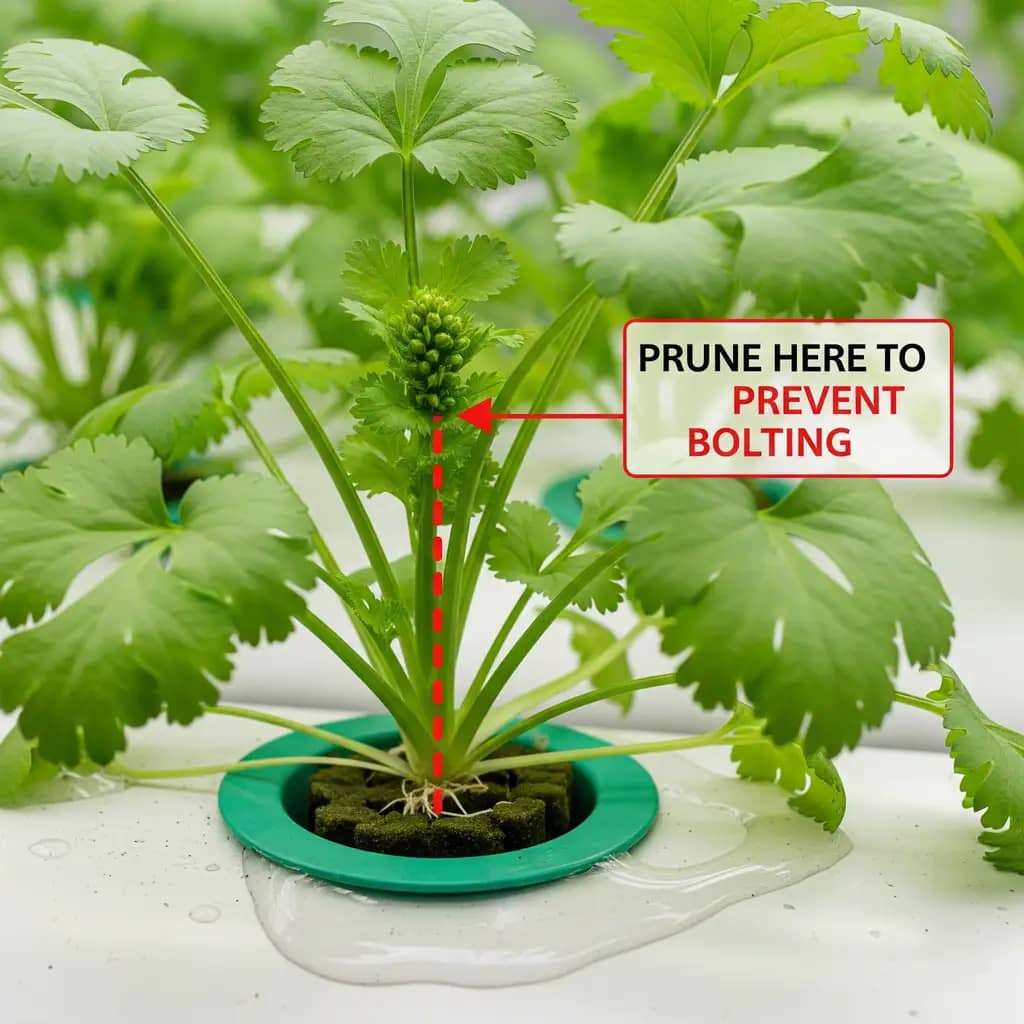
Nutrient Nuances: The Low-Nitrogen Focus
Both cilantro and rosemary are herbs where you want to maximize leaf flavor, not leafy bulk. This means you need to be cautious with nitrogen. Too much nitrogen, especially in the flowering stage, can lead to a bland, watery taste. We’re not growing lettuce; we’re growing flavor. My advice is a low-nitrogen formula, especially for rosemary.
For both herbs, start with a balanced formula and monitor their growth. If you see rapid, floppy growth, pull back on the nitrogen. If you see yellowing of the lower leaves, you may have a nitrogen deficiency. My advice: use a gentle hand with the fertilizer. A little goes a long way.
Nonna’s Secret #2: To prevent nutrient imbalances and ensure your herbs are getting a full spectrum of food, do not top up your reservoir. Empty your reservoir completely every 7-10 days, rinse it, and refill it with a fresh nutrient solution. This “fresh start” method, though seemingly wasteful, guarantees your plants get the right food every time and prevents salt buildup. This is especially important for cilantro, which is so sensitive to its environment.
Pruning for Potency: The Alchemist’s Touch
Pruning isn’t just about making your plants look tidy; it’s how you signal to the plant what you want. You are directing its energy. For cilantro, it’s a race against time. For rosemary, it’s about shaping a future of abundance.
Cilantro Flower Alerts: Your Bolting Alarm System
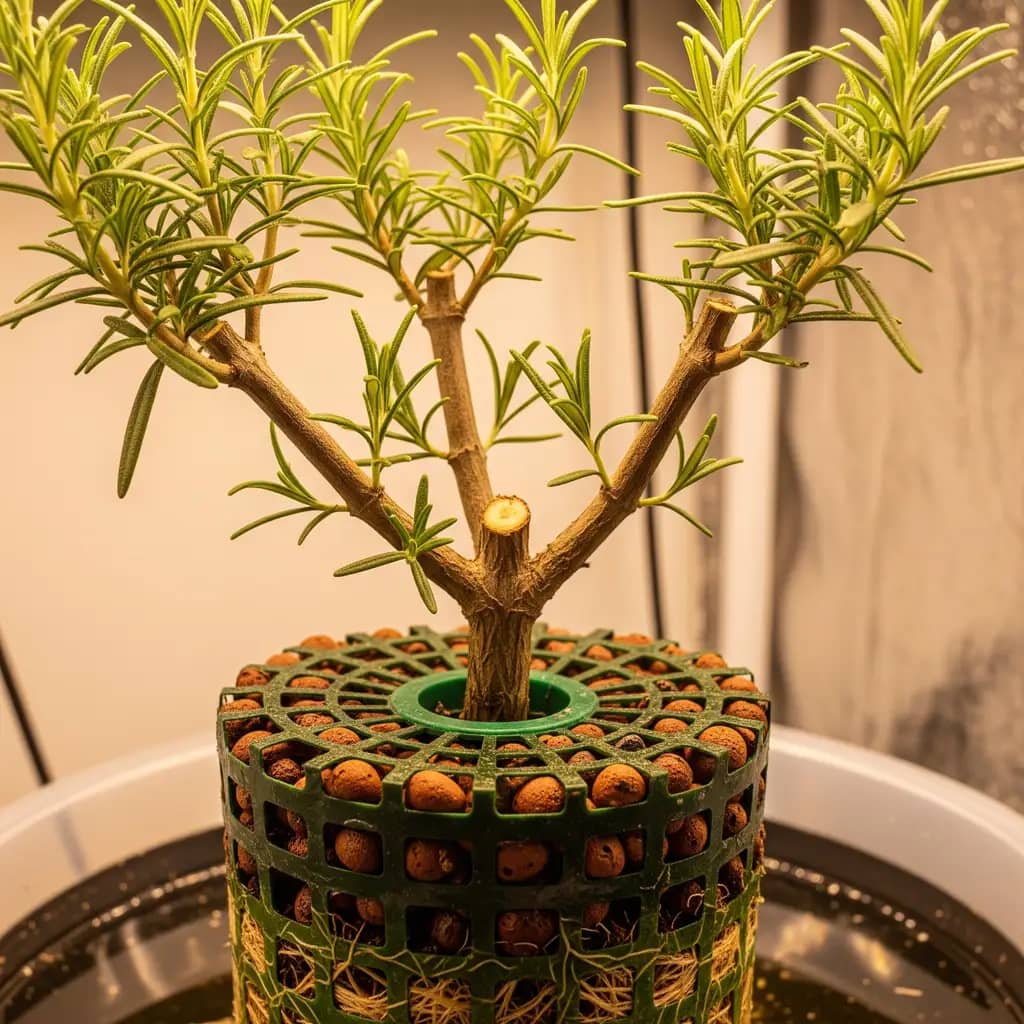
This is the most crucial part of cilantro cultivation. Cilantro’s goal is to reproduce. We must prevent it from doing so. Your “bolting alarm system” is your eyes. You’re looking for a small, central stem shooting up from the middle of the plant. This is a flower stalk.
The moment you see this, snip it. Cut it off at its base. This will buy you a week or two of leafy growth before the plant tries again. This technique, combined with a cool root temperature, is your best defense against bolting.
Nonna’s Secret #3: For a high-yield, continuous cilantro harvest, try succession planting. Every two weeks, start a new batch of seedlings. By the time your first crop is bolting, your third crop is ready for harvest. It’s how I ensure I have fresh salsa ingredients every week of the year.
Rosemary Shaping Secrets: The Bonsai of Herbs
Rosemary grows slowly, but with a plan, you can shape it into a robust, productive bush. When you harvest, instead of just taking leaves, prune the tips of the branches. This encourages the plant to branch out, creating a fuller, more aromatic plant. The goal is a dense, woody plant, not a tall, spindly one.
When your rosemary has been growing for a few months, and you’re ready for a heavy harvest, don’t take more than 25% of the plant at once. This prevents shock and allows the plant to recover quickly. A properly pruned rosemary bush will look like a miniature tree, a testament to your patience and skill.
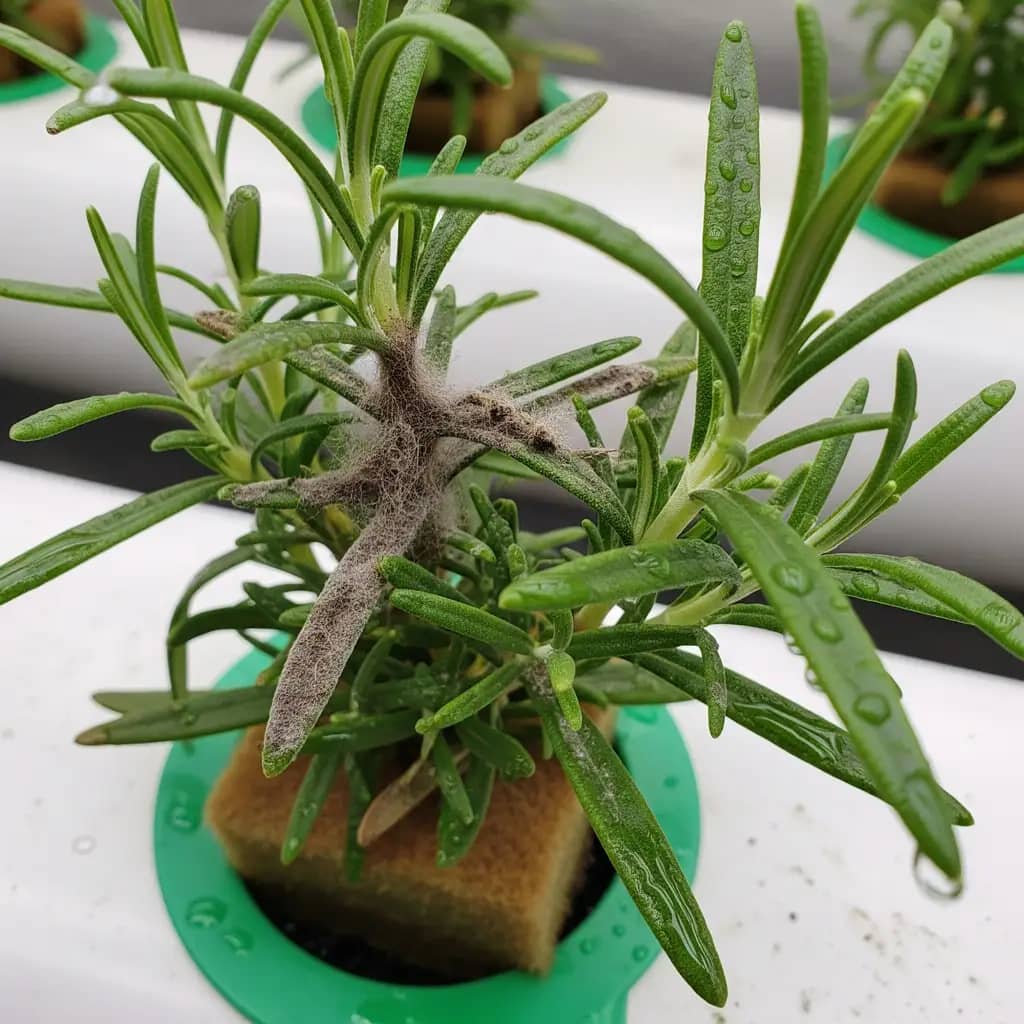
Fungus Fight Club: Powdery Mildew/Botrytis Protocol
This is the club no one wants to join, but you must be ready to fight. Powdery mildew and Botrytis (gray mold) are the most common fungal diseases you’ll face with these herbs.
- Powdery Mildew: This looks like a ghostly white powder on the leaves. It thrives in high humidity and poor air circulation. My Roman nonna’s trick was to use a simple baking soda spray: 1 tablespoon of baking soda per gallon of water. Spray this on the leaves once a week. It alters the pH on the leaf surface, making it an unwelcome home for mildew. This is “nonna’s secret remedy” in action.
- Botrytis: This is a gray, fuzzy mold that attacks weakened stems and leaves. It’s often a sign of high humidity or a lack of airflow. The best defense is prevention: good air circulation and pruning to promote air movement. If you see it, cut the infected area out immediately and dispose of it. If it’s on rosemary, you’re most likely dealing with poor airflow within the plant’s dense branches.
Herb Alchemist’s Toolkit: My Proven Products
Here are the tools and products I use in my kitchen and commercial gardens. Every item here has been kitchen-proven to produce results that would make any nonna proud. These are not just gadgets; they’re the gear that built my reputation.
Disclaimer: This section contains affiliate links. As an Amazon Associate, I earn from qualifying purchases. This helps keep the blog running and the tips flowing!
General Hydroponics Flora Series Performance Pack
This is a classic for a reason. The three-part system (Micro, Grow, Bloom) lets you mix custom ratios for every stage. It’s the most versatile option out there, and once you get the hang of it, you can dial in a perfect recipe for your plants. It’s the standard that many of us started with, and still rely on.
- The Flora Series is a hydroponic-based nutrient system that helps fulfill your plants’ nutrient needs at every stage of …
- Nutrients included in the Series are FloraMicro, FloraBloom, and FloraGro
- FloraMicro: contains nitrogen and calcium, as well as trace minerals, which are essential for a comprehensive hydroponic…
Why Growers Love It:
- Complete Nutrition: Three-part system provides precise control over each growth phase
- pH Stability: Buffered formulation minimizes pH drift in reservoir
- Strain Specific: Feeding charts available for various cannabis genetics.
Room for Improvement:
- Mixing Order: Requires specific mixing sequence to prevent nutrient lockout.
- Supplement Needs: May require additional PK boosters for heavy-feeding strains.
Bottom Line for Growers: The industry standard for reliability. Perfect for growers who want predictable results harvest after harvest. Check Price on Amazon.
Bluelab Combo Meter for pH, Temperature & Conductivity in Water
A professional-grade handheld meter that simultaneously monitors pH, conductivity (EC/TDS/PPM), and temperature in hydroponic solutions, ensuring precise nutrient management for optimal plant health.
- Monitor 3 parameters in water: Conductivity (TDS) level to ensure plants get a balanced feed, pH up and down, and temper…
- This hydroponics meter has ATC that provides consistent reading regardless of any fluctuations in temperature; pH probe …
- Combine with Bluelab meters and controllers for full indoor garden nutrients monitoring in water and soil; pH probe requ…
Why Growers Love It:
- Triple-Parameter Monitoring: Tracks pH, EC/TDS/PPM, and temperature simultaneously, eliminating the need for multiple devices and ensuring perfect nutrient balance.
- Lab-Quality Precision: Features automatic temperature compensation (ATC) and a double-junction pH probe for accurate readings despite environmental fluctuations.
- User-Friendly Design: Includes a backlit display, customizable units (EC, CF, PPM 500/700), and auto-off functionality to conserve battery life.
Room for Improvement:
- Probe Care Required: The pH probe requires regular calibration and proper storage (storage cap included, but care kit sold separately) to maintain accuracy.
- Initial Investment: Higher upfront cost compared to basic meters, but justified by long-term reliability and precision.
Bottom Line for Growers: The industry standard for serious hydroponic growers. Its lab-grade accuracy and durability make it indispensable for avoiding nutrient lockout and maximizing yields. Check Price on Amazon.
Barrina LED Grow Lights 2FT, 4-Pack
Full-spectrum T5 LED lights providing the 12-16 hours of daily light cilantro and rosemary need for optimal growth
- 5000K Full Spectrum: Barrina T5 grow lights, offer the most reasonable grow light wavelengths based on the ratio of plan…
- High PPFD: This grow light strip with high PPFD maximize photosynthesis efficiency and promote rapid, healthy plant grow…
- 3-in-1 Installation: With included double-sided tape, clips and cable ties, you could easily install the led plant light…
Root-Level Benefits:
- Full Spectrum: Offers balanced light for both herbs, promoting vigorous vegetative growth and enhancing essential oil production in rosemary.
- Energy Efficient: Low heat output allows placement close to plants without burning delicate leaves.
- Easy Installation: Daisy-chain design and included hanging kits make setup simple for shelves or small spaces.
Not a Perfect Fit For:
- Large Gardens: This 4-pack covers a 2-ft x 4-ft area; larger setups require additional lights.
- Flowering Plants: Best for leafy herbs; flowering plants may need more intense lighting..
Our Grow-O-Meter Says: Perfect for indoor herb gardens. Provides consistent light for cilantro’s fast growth and rosemary’s slower, woody development . Check Price on Amazon.
VIVOSUN 5-Pack 5-Gallon Bucket Lid with Net Pots
A deep water culture (DWC) kit ideal for rosemary’s extensive root system and cilantro’s rapid growth
- DWC Bucket +Top Drip Kit: The upgraded hydroponic system incorporates a unique top drip irrigation design, facilitating …
- Powerful Air Pump: Air output: 4*4 L/min (adjustable); Voltage: AC110-120V/60Hz; Power: 8W; The air pump and air stones …
- Grow Faster, Harvest More: The upgraded DWC system accelerates plant growth and increases yield potential; With independ…
Bloom & Boost:
- Root Space: 5-gallon buckets provide ample room for extensive tomato or pepper root systems.
- Durable Construction: Food-grade buckets with light-proof lids prevent algae growth.
- DIY Flexibility: Build a custom system for specific fruit plants’ needs.
Bloom & Boost:
- Space Requirements: Buckets need significant room; may not suit small spaces.
- Maintenance: Regular nutrient changes required, especially for heavy-feeding cilantro.
Is It Right For Your Garden? Best for growers with enough space to dedicate separate buckets to each herb, ensuring tailored care See Latest Discount.
Rapid Rooter Plant Starter Plugs, 50 Count
An ideal germination medium for starting cilantro seeds and rosemary cuttings, ensuring strong root development.
- Rapid rooter plugs are fortified with general hydroponic micronutrients for abundant root growth
- The optimal air-to-water ratio within the plug matrix results in explosive early root growth
- Use rapid rooter for robust early rooting that supports explosive plant growth
Grow Room Win:
- High Success Rate: Promotes rapid germination for cilantro (7-10 days) and rooting for rosemary cuttings.
- pH Balanced: Pre-adjusted to neutral pH, reducing transplant shock when moving to hydroponic systems.
- Versatile: Works with all hydroponic setups, including DWC and drip systems.
The Trade-Off:
- Drying Out: Can dry quickly under strong lights; requires consistent moisture monitoring.
- Size: May be too large for very small propagation setups.
The Final Verdict: Simplifies the critical early stages of growth, giving both herbs a strong start. See Latest Discount.
Botanicare Cal-Mag Plus, 1-Quart
A calcium-magnesium supplement essential for preventing deficiencies in cilantro and supporting rosemary’s structural strength
- Botanicare Cal-Mag Plus 2-0-0 is a highly fortified calcium, magnesium, and iron plant supplement
- Corrects common deficiencies
- Use during the vegetative, transition, and bloom stages of growth
The Green Thumb Upside:
- Deficiency Prevention: Prevents tip burn in cilantro and strengthens cell walls in rosemary.
- Enhanced Uptake: Chelated formula ensures availability even in suboptimal pH conditions.
- Versatile Use: Can be added to reservoirs or used as a foliar spray for quick correction.
Grower’s Notes:
- Regular Use Needed: Must be applied consistently, especially with RO water or coco coir.
- Dosage Care: Overuse can cause nutrient lockout; follow instructions carefully.
The Seedling Lowdown: Crucial for hydroponic herb gardens. Addresses common issues that arise when growing these two herbs together. Check Price on Amazon.
Conclusion: Your Aromatic Legacy Awaits
Cultivating cilantro and rosemary in hydroponics is a journey of discovery and dedication. By respecting their individual needs—from cilantro’s cool roots to rosemary’s love of oxygen—you can create a bountiful garden that produces flavors far beyond what you can find in any store. This is your chance to become a true alchemist of the kitchen, turning water and light into fragrant, potent herbs. With a little patience, the right tools, and a deep respect for these ancient plants, you will be rewarded with a harvest that is a source of pride, health, and flavor.
Nonna’s Basil Secret: For a high-yield, continuous basil harvest, try succession planting. Every two weeks, start a new batch of seeds. By the time your first crop is bolting, your third crop is ready for harvest. It’s how I ensure I have fresh basil every week of the year.

